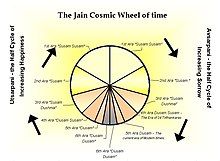Kāla
This articleneeds additional citations forverification.(June 2011) |

Kala(Sanskrit:काल,romanized:Kālá/Kālam,[2]IPA:[kɑːˈlə]) is aSanskritterm that means 'time'[3]or 'death'.[4]Astime personified,destroying all things, Kala is a god ofdeath,and often used as one of the epithets ofYama.InShaivism,Kala is known as the fiery avatar of Shiva,Kala Bhairavaor Kalagni Rudra; and inVaishnavismKala is also associated withNarasimhaandPralaya.[5]As applied to gods and goddesses,Kāláis not always distinguishable fromkāla,meaning 'black'.[4]
Etymology[edit]
Monier-Williams's widely used Sanskrit-English dictionary[4]lists two distinct words with the formkāla:
- kāla1 means "black, of a dark colour, dark-blue..." and has a feminine form ending inī–kālī– as mentioned inPāṇini4–1, 42.
- kālá2 means "a fixed or right point of time, a space of time, time... destiny, fate... death" and has a feminine form (found at the end of compounds) ending inā,as mentioned in theṛgvedaPrātiśākhya.As atraditional Hindu unit of time,onekālácorresponds to 144 seconds.
According to Monier-Williams,kāla2 is from the verbal rootkal"to calculate", while the root ofkāla1 is uncertain, though possibly the same.[4]
As applied to gods and goddesses in works such as theDevīMāhātmyaand theSkandaPurāṇa,kāla1 andkāla2 are not readily distinguishable. Thus Wendy Doniger, translating a conversation betweenŚivaandPārvatīfrom theSkandaPurāṇa,saysMahākālamay mean "'the Great Death'... or 'the Great Black One'".[6]AndSwāmīJagadīśvarānanda,a Hindu translator of theDevīMāhātmya,renders the feminine compoundkāla-rātri(whererātrimeans "night" ) as "dark night of periodic dissolution".[7]
Deity[edit]

Epics and the Puranas[edit]
Kala appears as an impersonal deity within theMahabharata,theRamayana,and theBhagavata Purana.In the Mahabharata,Krishna,one of the main characters, reveals his identity as Time personified. He states toArjunathat both sides on the battlefield of theKurukshetra Warhave already been annihilated. At the end of the epic, the entireYadudynasty (Krishna's dynasty) is similarly annihilated.
Kala appears in theUttara Kandaof the Ramayana, as the messenger of Death (Yama). At the end of the story, Time, in the form of inevitability or necessity, informsRamathat his reign on Earth is now over. By a trick or dilemma, he forces the death ofLakshmana,and informs Rama that he must return to the realm of the gods. Lakshmana willingly passes away with Rama's blessing and Rama returns toVaikuntha.
Time appears in the Bhagavata Purana as the force that is responsible for the imperceptible and inevitable change in the entire creation. According to the Purana, all created things are illusory, and thereby subject to creation and annihilation, this imperceptible and inconceivable impermanence is said to be due to the march of Time. Similarly, Time is considered to be the unmanifest aspect of God that remains after the destruction of the entire world at the end of a lifespan ofBrahma.According to Soifer,Narasimhais explicitly linked withPralayaor Yuganta itself inBhagavata Purana,Linga Purana,andKurma Puranaversions; he is said to appear like Kala or the fire of destruction, both agents of Pralaya.[5]
In theChaitanya Bhagavata,aGaudiya Vaishnavatext and biography ofChaitanya Mahaprabhu,it is said that the fire that emerges from the mouth ofSankarshanaat the End of Time is theKālānala,or "fire of Time".[8]One of the names of Sankarshana iskālāgni,also "fire of time".[9]
TheVishnu Puranaalso states that Time (kala) is one of the four primary forms of Vishnu, the others being matter (Pradhana), visible substance (vyakta), and Spirit (Purusha).[10][11]According to Pinchman, "It is said that at the time of primordial creation, three forms arise fromVishnu:time (kala),purusha,andprakrti".[12]
Bhagavad Gita[edit]
AtBhagavad Gita11.32,Krishnatakes on the form ofkāla,the destroyer, announcing to Arjuna that all the warriors on both sides will be killed, apart from the Pandavas:
कालो ऽस्मि लोकक्षयकृत् प्रवृद्धो लोकान् समाहर्तुम् इह प्रवृत्तः ।
Time (kāla) I am, the great destroyer of the worlds, and I have come here to destroy all people.[13]
— Bhagavad Gita, Verse 11.32
This phrase is famous for being quoted byJ. Robert Oppenheimeras he reflected on theManhattan Project's explosion of the first nuclear bomb in 1945.
In other cultures[edit]
In Javanese mythology,Batara Kalais the god of destruction. It is a very huge mighty and powerful god depicted asgiant,born of the sperm ofShiva,the kings of gods.
InBorobudur,the gate to the stairs is adorned with a giant head, making the gate look like the open mouth of the giant. Many other gates in Javanese traditional buildings have this kind of ornament. Perhaps the most detailed Kala Face in Java is on the south side ofCandi Kalasan.
InThailand,he is popular worshipped together withLak MueangwithinTai folk religionandChitraguptainHinduism.[14]
Jainism[edit]


InJainism,Kāla (Time) is infinite and is explained in two different ways:
- The measure of duration, known in the form of hours, days, like that.
- The cause of the continuity of function of things.
HoweverJainismrecognizes a very smallmeasurementof time known assamayawhich is an infinitely small part of asecond.There are cycles (kalachakras) in it. Each cycle having two eras of equal duration described as theavasarpiniand theutsarpini.
See also[edit]
References[edit]
- ^"ศาลหลักเมืองกรุงเทพมหานคร (Bangkok City Pillar Shrine)".
- ^www.wisdomlib.org (14 September 2019)."Kalam: 6 definitions".www.wisdomlib.org.Retrieved4 November2022.
- ^Dalal 2011,p. 185.
- ^abcdMonier-Williams, Monier (1899)."Sanskrit Dictionary".Retrieved4 October2023.
- ^abSoifer 1991,p. 102.
- ^Doniger O'Flaherty, Wendy;Hindu Myths;Penguin, 1975;ISBN0-14-044306-1footnote to page 253.
- ^Jagadīśvarānandatrans;Devi Mahatmyam(Sanskrit and English); Sri Ramakrishna Math, Madras, 1953; chapter 1 verse 78.
- ^Thakura, Vrndavana Dasa.Chaitanya-Bhagavata.Translated by Sarvabhavana Dasa. p. 203.
- ^"A Thousand Names of Lord Balarama".
- ^Wilson, Horace H. (1840). "Preface".The Vishńu Puráńa: A System of Hindu Mythology and Tradition.pp. ix.
- ^Roy, Janmajit (2002). "Signs and Symptoms of Avatārahood".Theory of Avatāra and Divinity of Chaitanya.New Delhi: Atlantic Publishers & Distributors. p. 66.
- ^Pintchman 2001,p. 83.
- ^Seetext and translation
- ^"ศาลหลักเมืองกรุงเทพมหานคร (Bangkok City Pillar Shrine)".
Sources[edit]
- Dalal, Roshen (5 October 2011).Hinduism: An Alphabetical Guide.Penguin Books India.ISBN978-0-14-341421-6.Retrieved19 December2012.
- Pintchman, Tracy, ed. (2001),Seeking Mahadevi: Constructing the Identities of the Hindu Great Goddess,SUNY Press
- Soifer, Deborah A. (1991).The Myths of Narasimha and Vamana: Two Avatars in Cosmological Perspective.SUNY Press.ISBN9780791407998.

